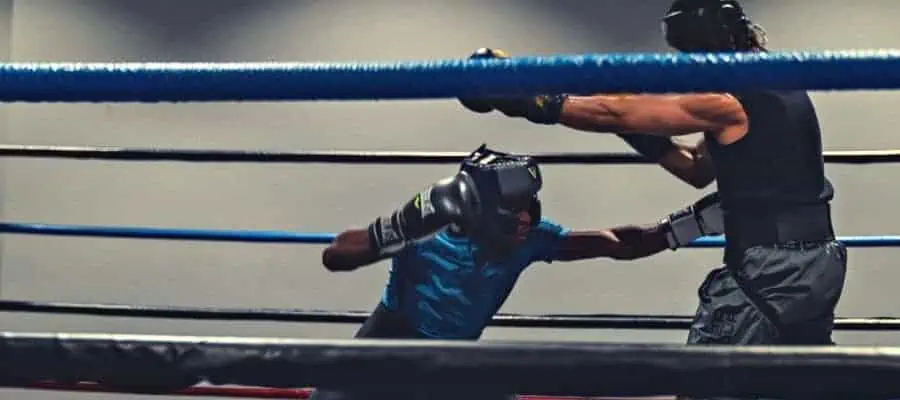Feint in boxing is a trick that is executed to distract or confuse the opponent. It makes him think that one specific movement is going to be done, when in fact a completely different movement is being done or not being done at all.
This is especially important when the opponent is a master of defense, and you need to find a way to open it for the attack. Feints are an almost forgotten boxing technique. Now they are not seen as often as they used to be. And it is upsetting because adding feints to your boxing skills list will make you a better fighter.
Half Punch

The name of this feint speaks for itself. But here you need the right technique and mindset. You need it to keep your gameplay and not to let your opponent predict your moves. Your goal is to throw a mid-range (or slightly shorter) punch without fully tensing any part of your body. For example, you throw a half jab or cross.
This will force your opponent to move in your favorable direction so that you can deliver the real punch. For example, after a half cross, you throw a lead hook. It is important not to overdo it because a smart fighter will sooner or later figure out your tricks. Then he will wait for the next feint and will try to counterattack you. So be careful.
Step Forward

There aren’t many boxers who can do this feint effectively. It may sound simple, but the step forward is not the most important thing here. This feint should be done when you are close to the opponent. At this point, it is easy for your opponent to think that right now you’re going to jump forward and attack him.
From his side, he will have an opportunity to execute some combinations. You make a sharp jerk with your body at the same time as you step. And it’s all done in one quick move. If anyone, does it well, it’s Manny Pacquiao. He’s used this move many times to knock his opponent out or send him to the ground.
Your opponent will try to step back to avoid the oncoming punch. Then you take another step forward, to get closer and throw another unexpected punch. This is quite risky and requires fast footwork. Sometimes your opponent can dodge the punch without stepping back. This is a good time to catch your opponent with the combination attack.
Fake Slip

Do not mix this feint up with a head movement or a sliding punch. Because it is not used to dodge punches, but more to open up your opponent’s defense. When you slip to the side you don’t have to do it quickly, it’s recommended to slip to the outside of the leading leg, so you can easily throw a hook.
A good example of this feint you can see is Sergio Martinez’s fights, especially against Julio Cesar Chavez Jr.
Knee Bends

To get more powerful punches, you need to do one thing, which is to bend your legs a little bit when you punch. A little squat signs us a start of punch execution. You don’t want to squat too low, as it would be difficult to get back to the starting position to attack your opponent.
All you must do to trick your opponent is to bend your knees a little bit and make a small movement with your hands imitating the attack. An example of a fighter who often uses this feint is Guillermo Rigondeaux. He was a great amateur boxer and is a unified world champion.
Distracting Jab

There are two ways to use the jab as a feint. First, you can throw a full long-range jab, but do not throw it at your opponent. You need to throw it a little bit away from the opponent’s head, without touching him. The second way is to pretend to throw a half jab without fully straightening your arm
Imagine you notice that your opponent moves similarly every time you throw a jab. For example, you’ve recognized that he always slips left or right. The next time you throw a jab you’ll be able to hit where you already know his head will be.
Switching From Head To Stomach

A good feint that very often works is the switch of the punch from the head to the body. This is done by throwing a few punches with the front hand to the opponent’s head. After that, it often happens that the opponent will be waiting for another punch to the head.
But this time as if throwing a punch to the head sharply redirects the punch to the opponent’s stomach.
Fake Cross To The Stomach

The move is opposite to the previous feint. Here we lift the hand from the stomach to the head with a front hook. Here we also hit the opponent in the stomach a few times to get him used to our moves. Then we squat a little bit to create a fake execution of the punch to the stomach, and at this moment we throw a front hook to the opponent’s head.
Fake Jab

This feint is performed during a jab. It is something like an overhand and hook with the front hand. It is done when we notice that the opponent often defends himself against the jab by hitting it down with his backhand. We throw a couple of jabs.
Next time the opponent tries to hit a jab with his hand and open his defense, we throw an overhand punch into his jaw.
Shoulder Feint

This is one of the most common feints in boxing and other combat sports. Also, it is the easiest feint to execute. But may not be immediately successful by beginners. Because this feint requires keeping the shoulders relaxed. The problem is that the beginners are too locked in their shoulders, and the rest of their moves.
The idea of this feint is to pop your shoulder as if imitating a punch execution. This action often makes the opponent react in one way or another. Therefore, the fighter can analyze the opponent’s reaction and build the right attack combination.
Gaze Feint

A boxer’s sense of self-preservation is caused by the danger of getting hit during a fight. It causes him to concentrate his attention on his opponent’s eyes. The boxer can predict the actions of his opponent by his opponent’s gaze. Boxer follows his opponent’s body movements and watches where his gaze is directed.
At this point, the boxer tries to determine what punch the opponent will execute and prepare a counterattack. Through the opponent’s gaze, you can see his physical and mental state and use it to determine your attack strategy in a fight. The less the emotions of your opponent are controlled, the easier he reveals his game strategy to the opponent.
There is a negative side here for the opponent. With the help of the gaze, the fighter can easily deceive his opponent. For example, a boxer will signal with his gaze that he will deliver a punch to the stomach. The opponent prepares for this attack, but the boxer looking at the stomach will deliver a punch to the head.
That’s why you should try to look at your opponent’s chin and not at the eyes. This will help you not get caught in that feint.
Joe Gans’ Double Feint

Joe Gans was an American boxer. He won the title of world lightweight champion in 1902 in Fort Erie (Canada). That same year he moved up to the welterweight division. Joe Gans distinguished himself in his fights by his knockout skills. In his mastery, Joe Gans is on a level with such boxers as Sugar Ray Leonard, Kid McCoy, and Gene Tunney.
They entered the history of boxing as scientific boxers. Joe Gans used feints very skillfully. They were designed to open up his chosen point of attack. One of the most interesting is the double feint, which opened up the head defense for the right hook.
When he did this, Gans first threw a few fake jabs to the head. Then, dropping his left hand, he took a step forward, as if preparing to punch his opponent in the stomach. The opponent thought the first feint was just to force him to keep his hands up to protect his head.
And seeing that Gans left hand was moving to his stomach, he lowered his right hand to protect himself. But although his left hand stayed free to protect his head, his mind was focused on protecting his stomach. It was no longer difficult for Gans to deliver a right hook to his opponent’s head at this point.
This feint, built on attacking alternately two points on the opponent’s body. It can be used as an example for various combinations in which the punch returns to the originally attacked target. To do it successfully, you must be able to make your opponent believe that the threat of the fake body target is real.
Defense Opening

This type of feint means that the boxer knows in advance the opponent’s favorite punch. So he calls him to attack by faking the opening of his defense. For example, the boxer knows that the opponent uses the right cross to make a strong attack. He lowers his left hand as if accidentally, and opens the defense of the head’s left side.
Seeing this, the opponent will try not to miss the opportunity to attack. But the boxer, carefully watching the start of the punch execution and catches it with a pre-prepared defense. With the pushing back of his left hand to the right side, he throws a counter-right uppercut to the body. The counter-punch should be performed from a defensive position.
In a fast tempo fight, a fake defense opening can be very successful. Boxer invites his opponent to attack with a variety of punches. Then effectively countering the attack with a prepared defense and combination. Tempted by the boxer’s low defense, the opponent will constantly repeat his punches, throwing them in an “open” defense without noticing the trick.
This way, the opponent’s strongest weapon will be directed against himself. This feint was a favorite technique for counterattacks by Jack Johnson. He was undisputed world champion 1908-1915. He won the title by defeating Tommy Burns on December 26, 1908.
He had excellent technique. During eight years he defended the champion title by beating all his opponents. Johnson’s favorite move is to call his opponent to attack with a right cross into open defense. By extending his right hand forward, Johnson would block his opponent’s left hand.
At the same time, he lowered his left arm, opening his head defense to his opponent’s right hand. The opponent, seeing an opportunity to deliver a knockout punch, rushed to attack Johnson with a straight punch. But Johnson’s left hand was suddenly ready to defend and moved the attack to the side.
As a result, the opponent would get a strong right uppercut to the head from Johnson that followed immediately after a defense move.
Covering The Opponent’s Eyes

Packey McFarland (one of the strongest lightweights in the world) sometimes used this trick in his attacks. He would make several long-range jabs with his left hand and leave it in front of his opponent’s face for a moment, covering his eyes with his glove.
At the same time, he broke the distance quickly to his opponent and executed a strong right uppercut to the head. The opponent, who was unable to see what happens, was usually confused and missed the chance for defense. As with all boxing feints based on surprise, Packey McFarland never used them too often.
Shift Punch

Shift-punch is a switch from a left-handed fighting stance to a right-handed stance. It happens when the boxer wants to throw a strong left-hand punch. This technique was created by Bob Fitzsimmons. He is a British professional boxer who became the first world champion in three divisions.
Fitzsimmons’ favorite punch was the left uppercut to the solar plexus. That’s what the entire tactical execution of the shift punch is based on. To execute a left uppercut, Fitzsaymons, as a left-handed boxer, had to get into a comfortable starting position. Also, at the same time, he had to open up his opponent’s body defense.
He had a special execution tactic for this. First, to distract his opponent, he used feints with his left hand, attacking his opponent’s head with it. Then at an opportune moment, he would throw a fake right punch to the head, as if with full power. In this way, he forced the opponent to raise his hands to protect his head.
At the same time with this basic feint, he would put his right leg forward, keeping his body weight on his left leg. In this way, he reached a starting position that was convenient for hitting with his left hand. The position of the opponent with his torso open and leaning back made him an easy target.
At the last moment, Fitzsimmons landed a strong punch into his opponent’s relaxed stomach and then a right hook to the head. This technique is very popular today among many boxers. It serves as a basic attacking move for left-handed boxers. A left-handed boxer needs to change his stance to the right to take a comfortable starting position.
From this position, he can attack more effectively with his strong left hand. This condition for a left-handed boxer is identical to that for a right-handed boxer who is more comfortable putting his power into right-handed punches from a left-handed stance.
Bolo Punch

Bolo punch is a punch that is made by turning the arm at the elbow and shoulder joints at the same time. The word bolo translates from Filipino as a machete. The bolo punch is disguised as a feint. The attacking boxer chooses the time to throw a punch. The punching arm is relaxed.
Targets for attacks: body and head. As a rule, the bolo punch in the final phase of the movement is similar to the uppercut but is performed on a larger range. The punch can be executed in two ways: as an attacking movement and as a feint to punch with the other hand. The Bolo Punch is conveniently executed from the far hand.
This is the basis of the punch, but there are exceptions to every rule. An example of the bolo punch from the front hand was demonstrated by Ike Ibeabuchi. On March 20, 1999, he knocked out Chris Bird. The classic bolo punch with the front hand. This punch was also often used by Sugar Ray Leonard.
I hope this article was useful for you. Good luck in boxing.
Recent Posts
What is Manachai's Fighting Style? Unveiling Muay Thai Mastery
Manachai, a celebrated figure in the Muay Thai world, has captivated audiences with his exemplary martial prowess. Hailing from the heartlands of Thailand, his name is synonymous with the art of...
What Was Chamuekpet Hapalang's Fighting Style? Unveiling Techniques
Chamuekpet Hapalang was a renowned figure in the world of Muay Thai (record 200-48-2), embodying a fusion of Muay Bouk and Muay Khao styles. Originating from Thailand, the art of Muay Thai is known...
